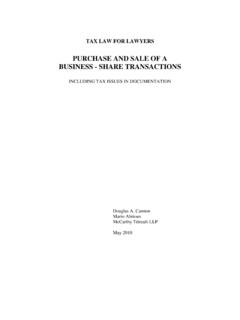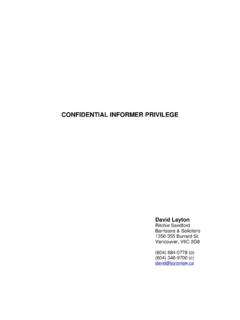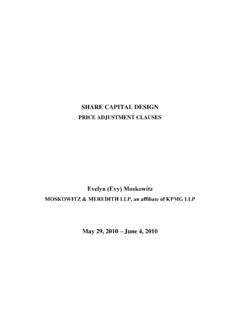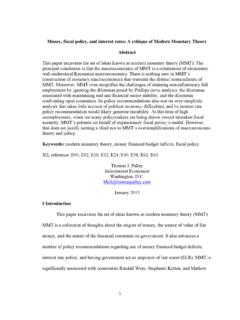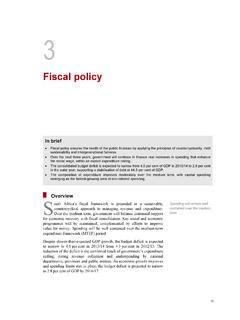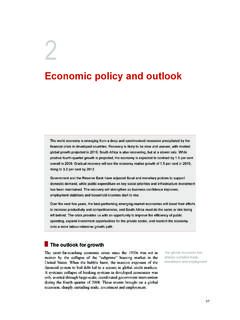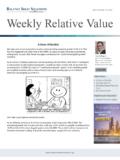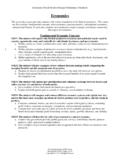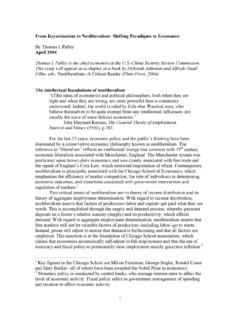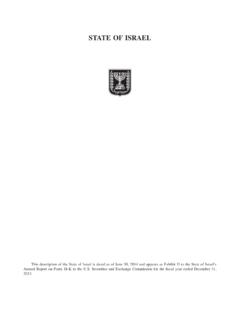Transcription of THE DEDUCTION OF FINANCING EXPENSES …
1 4674538 v9 THE DEDUCTION OF FINANCING EXPENSES OTHER THAN interest Ron Durand Stikeman Elliott LLP June 3, 20104674538 v9 ( i ) THE DEDUCTION OF FINANCING EXPENSES OTHER THAN interest INDEX 20(1)(e) - FINANCING EXPENSES ..1 Timing of the Expense ..4 Timing of the DEDUCTION ..5 Who may Deduct ..5 Repayment ..6 Dissolution of Partnership ..7 Amalgamation and Wind-up ..7 Discount or Fee for Underwriting ..7 Participation Payments ..8 Currency Hedge ..9 Warrants ..10 Guarantees ..10 Environmental Approval ..10 20(1)( ) - Annual Fees ..11 Interaction of Paragraphs 20(1)(e) and 20(1)( ) ..11 Annual Basis ..12 20(1)( ) - Insurance Premiums ..12 Treatment Prior to Paragraph 20(1)( ) ..12 Current Proration ..14 Relation to Amount Owing ..14 4674538 v9 ( ii ) 18( ) - Penalties, Bonuses and Rate-Reduction Payments ..15 Timing of DEDUCTION ..16 Exclusions ..17 SELECTED BIBLIOGRAPHY ..18 Paragraph 20(1)(e).
2 18 Paragraph 20(1)( ) - Annual Fees ..19 Paragraph 20(1)( ) - Insurance Premiums ..19 Subsection 18( ) - Penalties, Bonuses and Rate-Reduction Payments ..19 4674538 v9 THE DEDUCTION OF FINANCING EXPENSES OTHER THAN interest 20(1)(e) - FINANCING EXPENSES The purpose of paragraph 20(1)(e) is to permit the amortization over a five year period of certain FINANCING EXPENSES relating to: (1) an issue or sale of shares, units of unit trusts, or partnership or syndicate interests, (2) a borrowing of money used for the purpose of earning income that is not exempt, (3) the incurring of indebtedness for property that is acquired for the purpose of earning income that is not exempt, or (4) a rescheduling, restructuring or assumption of a debt obligation that is described in (2) or (3). All of these EXPENSES would otherwise be regarded as non-deductible capital expenditures.
3 Generally, the FINANCING EXPENSES contemplated by this paragraph include legal, accounting and other EXPENSES relating to the FINANCING , including, printing fees, registration fees, filing fees, commitment or standby fees, guarantee fees, promoter s service fees, loan arrangement fees, certification fees and certain other soft costs . These EXPENSES are deductible under paragraph 20(1)(e) at the rate of 20% for a full fiscal period of 365 days over a five year period. Payments on account of principal or interest are specifically excluded from a DEDUCTION under paragraph 20(1)(e), as are amounts that are contingent on the use or production from property or computed by reference to revenue, profit, cash flow, commodity price or any other similar criteria. interest is specifically dealt with under paragraph 20(1)(c). Paragraph 20(1)(e) contains a purpose test similar to that for interest deductibility under paragraph 20(1)(c).
4 In order for borrowing costs to be deductible, the borrowed money must be used by the taxpayer for the purpose of earning income from a business or property, the income from which is not exempt. For EXPENSES incurred after 1987, subsection 20(3) applies to paragraphs 20(1)(e) and ( ), and provides that, in general, borrowings used to repay existing debt will be considered to have been used for the same purpose as that debt so that FINANCING fees incurred in connection with the new debt will be deductible in accordance with those paragraphs. It is unclear what is meant by the phrase a borrowing of money . The proceeds from the sale of bankers acceptances are specifically included in the definition of borrowed money under subsection 248(1). However, it is the Canada 4674538 v9 - 2 - Revenue Agency s (the CRA ) administrative position that an assumption of a debt obligation does not constitute the borrowing of money.
5 Subparagraph 20(1)(e)( ) was added to explicitly include the assumption of a debt obligation. There was also a concern that a borrowing of money was not broad enough to include the purchase of assets through the use of instalment payments or promissory notes issued to the vendor. Subparagraph 20(1)(e)( ) was added to specifically include this type of indebtedness. Rescheduling or restructuring .. of a debt obligation is considered by the Department to generally describe changes to the rights and obligations of the parties to the debt obligation. They may include, inter alia, alteration of payment schedules, extension of maturity dates, alteration of interest rates and conversion or substitution of the original debt obligation to or with a share for another debt obligation. Specifically excluded are those payments to which subsection 18( ), as discussed below, would otherwise apply.
6 Example 1: A taxpayer has paid commitment fees to a financial institution with respect to a proposed loan to be used to acquire an income-producing investment. The taxpayer subsequently borrows the money from a different financial institution. The commitment fee paid to the first financial institution would be considered to be an expense incurred in the course of borrowing money within the meaning of subparagraph 20(1)(e)(ii) if the taxpayer used the borrowed money to acquire the income-producing investment. The actual FINANCING must be a substitute for the loan originally sought. To be deductible under paragraph 20(1)(e), EXPENSES must be applicable to the source of income. The preamble to subsection 20(1) provides that, in computing income from a business or property, there may only be deducted such amounts as are wholly applicable to that source or such part of those amounts as may reasonably be regarded as applicable thereto.
7 For the purposes of subparagraph 20(1)(e)(i), with respect to EXPENSES incurred in the course of an issuance or sale of securities, the CRA has interpreted this language to mean that the EXPENSES must be wholly applicable to the sale or issuance, and not merely a consequence or result of the sale or issuance. On this basis, the CRA takes the view that subparagraph 20(1)(e)(i) would generally not apply to investment banker fees paid for advice in connection with issuing shares on a merger or for a fairness opinion as to whether the terms of a share issuance are fair to existing shareholders. Fees paid to an investment banker are usually incurred in the course of acquiring a business involving the acquisition of share capital. Such costs should be added to the cost of the shares acquired by the purchaser. Consequently, this type of expense is usually not deductible pursuant to subparagraph 20(1)(e)(i).
8 4674538 v9 - 3 - Generally, the rules in paragraph 20(1)(e) are applicable only where the EXPENSES would not otherwise be deductible because of paragraphs 18(1)(a), (b) or (h). EXPENSES that do not meet the terms of paragraph 20(1)(e) may qualify as eligible capital expenditures, provided, of course, that the requirements of the definition of eligible capital expenditures in subsection 14(5) are met. Example 2: A corporation attempts to raise money through the issuance of debt. The debt proceeds are to be used by the corporation to finance its business activities. The corporation incurs various legal and accounting costs with respect to the attempt to raise money through the issuance of debt; however, ultimately, the loan transaction is not carried out. As such, the EXPENSES incurred do not meet the requirements for a DEDUCTION under paragraph 20(1)(e).
9 Assuming the borrowed money would not have been the taxpayer's stock-in-trade (as would be the case if the taxpayer is not a money lender), the borrowing would have been on account of capital and a DEDUCTION thereof would be denied pursuant to paragraph 18(1)(b). However, EXPENSES on account of capital and incurred for the purposes of gaining or producing income from a business may qualify as an "eligible capital expenditure" under that definition in subsection 14(5). Other rules may also apply to the treatment of certain FINANCING EXPENSES which may take precedence over the treatment in paragraph 20(1)(e). Paragraph 20(1)( ) is discussed below. Paragraph 20(1)(g) may apply in connection with share transfer fees and other similar fees deductible by a corporation. EXPENSES incurred to meet obligations imposed under a Securities Act or a Business Corporations Act may be deductible under subsection 9(1).
10 Certain outlays or EXPENSES relating to the construction, renovation or alteration of a building shall be included in computing the cost or capital cost of the building according to the rules in subsections 18( ) to ( ). Where a taxpayer borrows money for the purpose of acquiring depreciable property, EXPENSES incurred in the course of borrowing that money, that are otherwise deductible under paragraph 20(1)(e), may be capitalized along with the interest paid or payable thereon as part of the cost of the depreciable property, provided an election to do so is made under section 21. Where such costs are so capitalized, they form part of the capital cost of the depreciable property subject to capital cost allowance. Subsection 18(11) prohibits the DEDUCTION of interest and FINANCING EXPENSES on funds borrowed for the purpose of purchasing certain deferred annuities, paying premiums or contributions under RRSPs, registered pension plans, and deferred profit sharing plans after November 12, 1981, or making contributions to retirement compensation arrangements, net income stabilization accounts, accounts under prescribed provincial pension plans or registered education savings plans.
